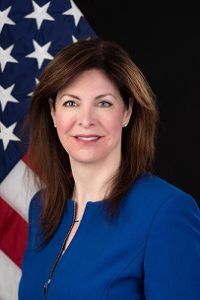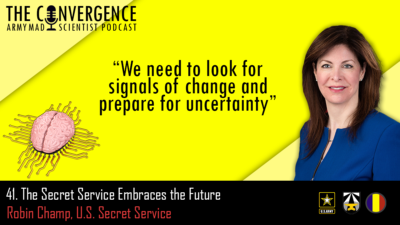[Editor’s Note: Army Mad Scientist is pleased to feature today’s episode of The Convergence podcast with Robin Champ, Chief, Enterprise Strategy Division, U.S. Secret Service, discussing national security, thinking about the future, and how emerging technologies and trends will affect Secret Service missions — Enjoy! (Please note that this podcast and several of the embedded links below are best accessed via a non-DoD network due to network priorities for teleworking)]
[If the podcast dashboard is not rendering correctly for you, please click here to listen to the podcast.]
 Robin Champ is the Chief of the Enterprise Strategy Division at the United States Secret Service (USSS), where she leads both foresight and strategic planning for the organization. Prior to joining USSS, Ms. Champ was the Chief of the Global Futures Office at the Defense Threat Reduction Agency (DTRA). Prior to joining DTRA, Ms. Champ worked at the Defense Logistics Agency (DLA), Office of Strategic Planning and Enterprise Transformation (J-5), where she was the DLA Lead for the 2010 Quadrennial Defense Review. In addition to her official positions, Ms. Champ Co-Leads the Federal Foresight Community of Interest (see links below). She also is a guest lecturer on foresight at George Washington University’s “Mastering Strategy for the Public Sector” course.
Robin Champ is the Chief of the Enterprise Strategy Division at the United States Secret Service (USSS), where she leads both foresight and strategic planning for the organization. Prior to joining USSS, Ms. Champ was the Chief of the Global Futures Office at the Defense Threat Reduction Agency (DTRA). Prior to joining DTRA, Ms. Champ worked at the Defense Logistics Agency (DLA), Office of Strategic Planning and Enterprise Transformation (J-5), where she was the DLA Lead for the 2010 Quadrennial Defense Review. In addition to her official positions, Ms. Champ Co-Leads the Federal Foresight Community of Interest (see links below). She also is a guest lecturer on foresight at George Washington University’s “Mastering Strategy for the Public Sector” course.
In today’s podcast, Ms. Champ discusses national security, thinking about the future, and how emerging technologies and trends will affect Secret Service missions. The following bullet points highlight key insights from our interview:
-
-
 Planning for the future involves analyzing trends and considering multiple alternate trajectories. Clearly communicating findings to leaders is essential to create actionable change, and particularly important when government agencies are tasked with ‘no fail missions.’
Planning for the future involves analyzing trends and considering multiple alternate trajectories. Clearly communicating findings to leaders is essential to create actionable change, and particularly important when government agencies are tasked with ‘no fail missions.’
-
-
-
 Generating foresight and creating strategy plans require the Government to fully leverage the nation’s talent. Recruiting and maintaining this workforce should be a priority for government agencies.
Generating foresight and creating strategy plans require the Government to fully leverage the nation’s talent. Recruiting and maintaining this workforce should be a priority for government agencies.
-
-
-
- The Secret Service has a robust foresight program, providing newsletters, speaker series, and strategic plans to its members. This program enables the Secret Service to identify and mitigate its weaknesses that could be taken advantage of during critical decisive
 moments. Readers and listeners can connect with the Federal Foresight Community of Interest at FFCOI.org and on their LinkedIn page.
moments. Readers and listeners can connect with the Federal Foresight Community of Interest at FFCOI.org and on their LinkedIn page.
- The Secret Service has a robust foresight program, providing newsletters, speaker series, and strategic plans to its members. This program enables the Secret Service to identify and mitigate its weaknesses that could be taken advantage of during critical decisive
-
-
-
 Trends considered in futures forecasting are constantly in flux, necessitating that agencies prepare for multiple possible futures simultaneously. Embracing endless possibilities and establishing networks of partners at home and abroad will allow the United States to prepare a resilient long term defense strategy.
Trends considered in futures forecasting are constantly in flux, necessitating that agencies prepare for multiple possible futures simultaneously. Embracing endless possibilities and establishing networks of partners at home and abroad will allow the United States to prepare a resilient long term defense strategy.
-
-
-
- Though typically associated with the protection of the President, the Secret Service is also mandated with the protection of U.S. currency from counterfeiters. This task has gotten increasingly
 challenging in the era of cryptocurrency, as criminal methods capitalize on this novel technology. However, new technologies have also provided the Secret Service with new techniques to trace financial flows and protect the U.S. currency.
challenging in the era of cryptocurrency, as criminal methods capitalize on this novel technology. However, new technologies have also provided the Secret Service with new techniques to trace financial flows and protect the U.S. currency.
- Though typically associated with the protection of the President, the Secret Service is also mandated with the protection of U.S. currency from counterfeiters. This task has gotten increasingly
-

Stay tuned to the Mad Scientist Laboratory for our next episode of The Convergence — Global Entanglement and Multi-Reality Warfare — featuring COL Stefan Banach (USA-Ret.), Director, Army Management Staff College, discussing global entanglement, multi-reality warfare, and the urgent need for a new paradigm and cognitive approach to warfare for the U.S. Army and larger Joint Force.
If you enjoyed this post and episode, explore the following related content:
Going on the Offensive in the Fight for the Future, and the associated podcast
The Convergence: The Future of Talent and Soldiers with MAJ Delaney Brown, CPT Jay Long, and 1LT Richard Kuzma, and the associated podcast
Young Minds on Competition and Conflict
Emergent Global Trends Impacting on the Future Operational Environment
Learning about the Future through Podcasts
Extremism on the Horizon: The Challenges of VEO Innovation, by Colonel Montgomery Erfourth and Dr. Aaron Bazin
Four Models of the Post-COVID World, The Operational Environment: Now through 2028, and The 2 + 3 Threat video
The Future Operational Environment: The Four Worlds of 2035-2050, the complete AFC Pamphlet 525-2, Future Operational Environment: Forging the Future in an Uncertain World 2035-2050, and associated video



